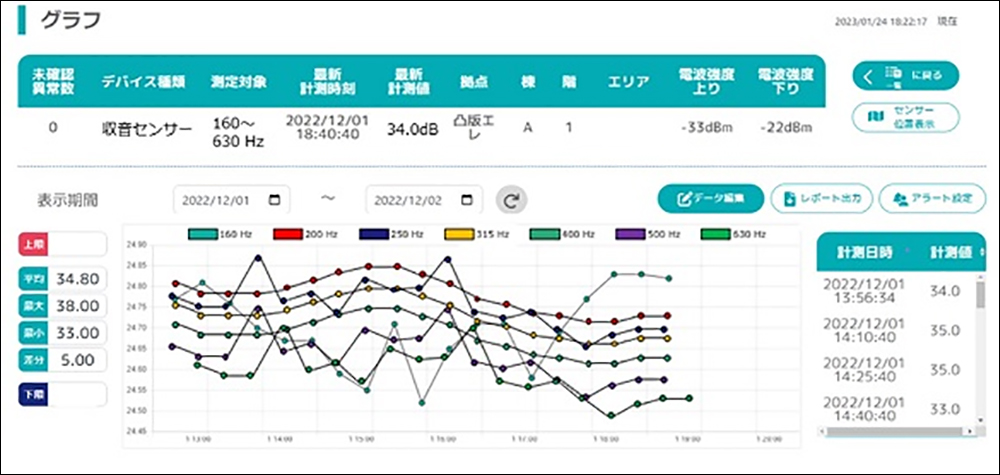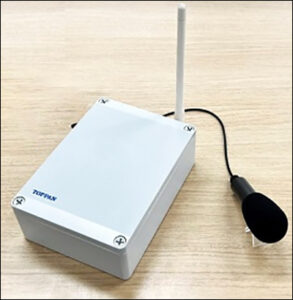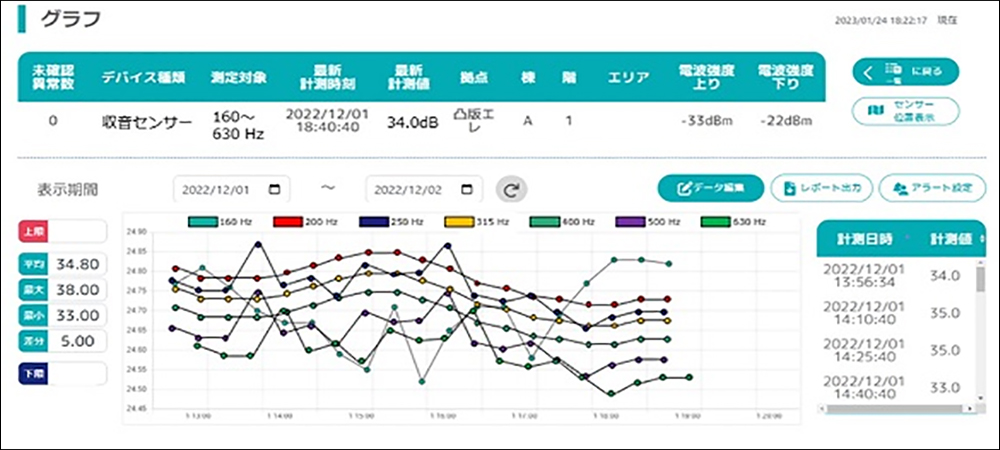RFID Journal LIVE! 2023 will feature end-user companies discussing RFID’s use in various industries, including manufacturing, as well as exhibitors offering tagging solutions for multiple applications. To learn more, visit the event’s website.
Global printing, communication, security, electronics and packaging firm Toppan has released its e-Platch wireless sensing solution with expanded functionality to include sound detection. By leveraging sound sensors and a data-management app, Toppan explains, the solution helps companies detect or prevent equipment failures. Businesses in Japan have begun deploying or testing the technology to identify abnormal sounds from equipment, and to differentiate them from normal background noises.
The collected data is transmitted to a server via ZETA‘s low-power wide-area network (LPWAN) technology, and the system can trigger alerts and provide reports based on those perceived abnormalities. The wireless Internet of Thing (IoT)-based e-Platch solution is intended to provide uninterrupted monitoring at manufacturing plants or other sites in which the operation of equipment is critical, Toppan indicates, and where maintenance inspection must be provided on a continual basis.

The system can detect sound changes indicating malfunctions or potential failures of critical equipment.
ZETA is an IoT frequency operating in the sub-1 GHz bands, such as 920 MHz. The technology is aimed at a universal challenge facing industrial or manufacturing sites: although equipment failures can often be predicted based on the sounds emitted from a machine, identifying those sounds can be highly problematic in a noisy environment, where other machinery creates a wide spectrum of background noise. Thus, Toppan built the e-Platch solution to listen for specific machinery problem sounds despite background noises, such as a loose bolt or friction between degrading parts. The system relies on ZETA communication to forward environmental data at set time intervals.
Expansion of Existing Condition-Monitoring Solution
Toppan first released a data-collection system using ZETA to capture sensor data in 2021. The following year, the company introduced the concept of its e-Platch solution, intended to collect a variety of environmental measurements including temperature, humidity and pH levels. The technology was tested during proof-of-concept projects conducted by its customers. Now, the e-Platch system is being fully released, including sound capability. The goal, according to Toppan, is to help businesses avoid the manual labor typically associated with physically checking equipment for signs of impending failures.

Toppan’s e-Platch wireless sensing solution
“In many factories, even if they want to improve the efficiency of inspection work with IT technologies, they often rely on patrol inspections by people,” says Masaharu Sadaya, the marketing manager of Toppan’s Electronics Division. That, he explains, is because radio wave communication is costly and does not always perform well in the noisy and highly metallic environment of factories or similar facilities.
“While promoting sales expansion of e-Platch,” Sadaya says, “we received requests from many customers for remote monitoring of environmental sounds, in order to deal with abnormal sounds and noise from factory equipment and utilities.” For this reason, the company decided to add sound sensors to the e-Platch lineup. While there are other sound-detection systems commercially available, he claims these are not necessarily as user-friendly since they can only be installed where a power supply is present and the equipment is relatively expensive.
Additionally, sound sensor technology is typically independent of other sensor systems. Toppan addressed this challenge by building functionality into the e-Platch solution. The sound sensors can be applied to a piece of equipment and be set to detect specific sounds. They can also be set to transmit data according to a predetermined frequency, such as every day or every 30 minutes, and relays are then deployed. Each sensor listens for specific sound patterns, then transmits wirelessly through the mesh network with the help of the relays, to an access point that acts as a gateway to forward data to a server.
Identifying Environmental or Mechanical Problems
The app measures sound intensity data for each of 21 frequency bands between 160 and 16,000 HZ, which is automatically plotted on graphs. The graph of the frequency band the user requires can be selected and viewed. The app also enables users to select frequencies for which they want to receive alerts, from among the 21 frequency bands. In this way, Toppan explains, the app identifies any sound anomalies that could be indicators of environmental or mechanical problems. In addition to sound, e-Platch can also manage temperature, humidity and pH levels, as well as liquid leakage, water levels, electric power and pressure.
Because sound measurement is built into the system’s broad environmental measuring platform, Toppan notes, companies are spared from installing multiple independent systems. The e-Platch sound sensors are battery-powered and can be installed in places where a secure power supply may not be available. Toppan says the cost is less than half that of conventional sound sensors which accomplish the same thing. “In the future,” Sadaya says, “we are considering improving the function so that we can perform data mining, in combination with AI [artificial intelligence], and determine abnormal states for each installation location.”
To employ the solution with sound detection, users would need to pay a monthly fee, as well as pay for the hardware and installation costs. One early adopter is a Japanese manufacturer that has installed the e-Platch sensors on air-conditioning units deployed on building rooftops. The system can also predict equipment failures. It is currently only available in Japan, though Toppan intends to commercialize the e-Platch solution outside of that country in the future. The company has not indicated when a global version will be released.
Key Takeaways:
- Japanese manufacturers are testing or deploying a wireless, battery-powered sensor system from Toppan, with the addition of sound sensing to identify potential equipment failures or conditions that could lead to such problems.
- While the technology is now only available in Japan, Toppan intends to release the solution globally in the future


